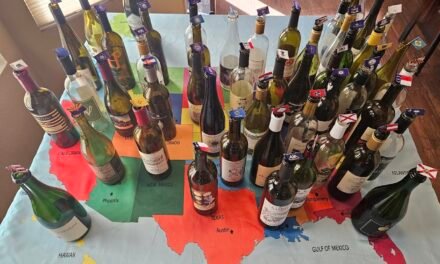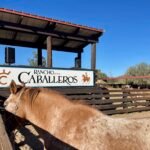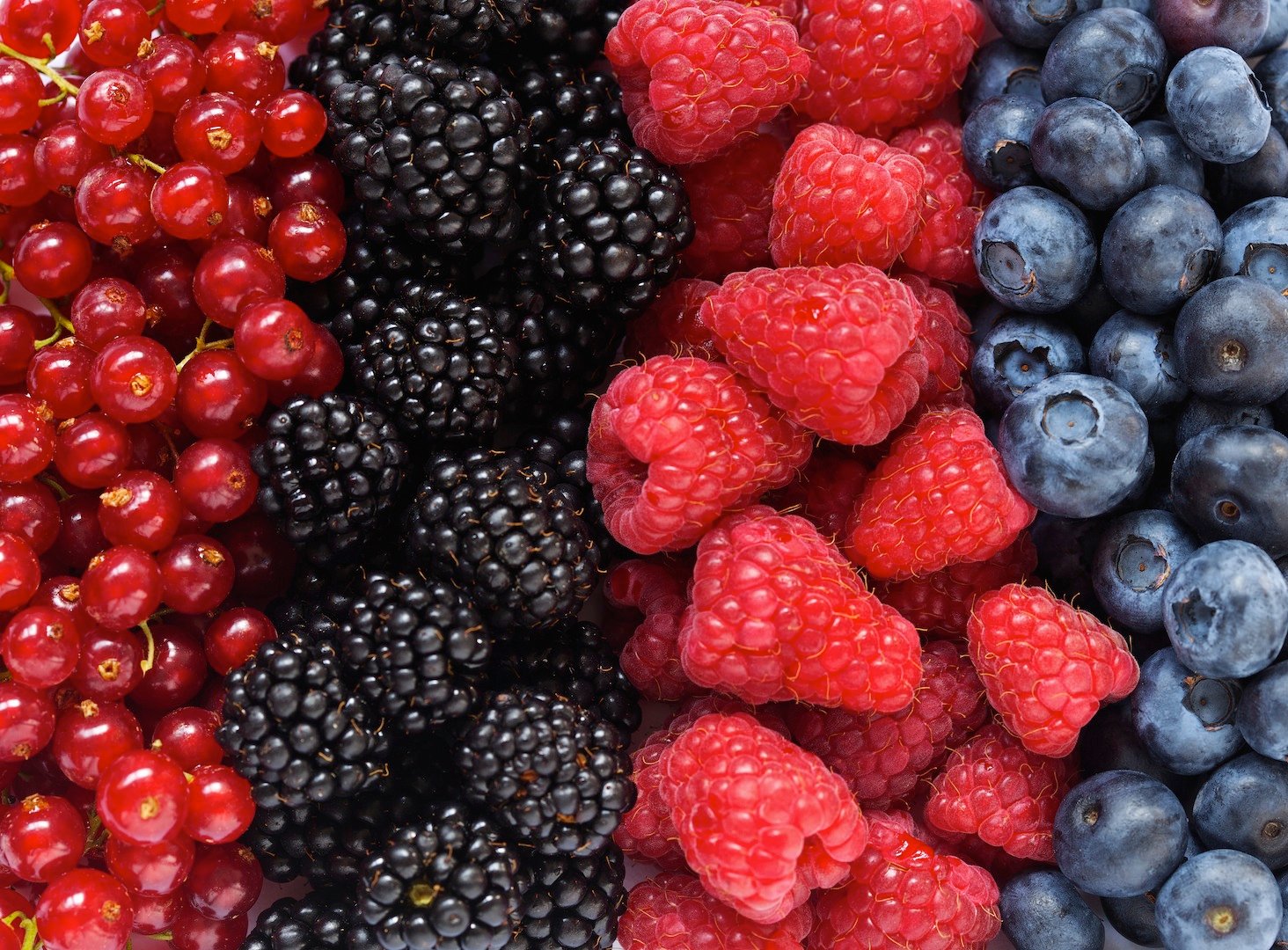
The Pairing Project: State Food with State Wine – Part 10 of 10
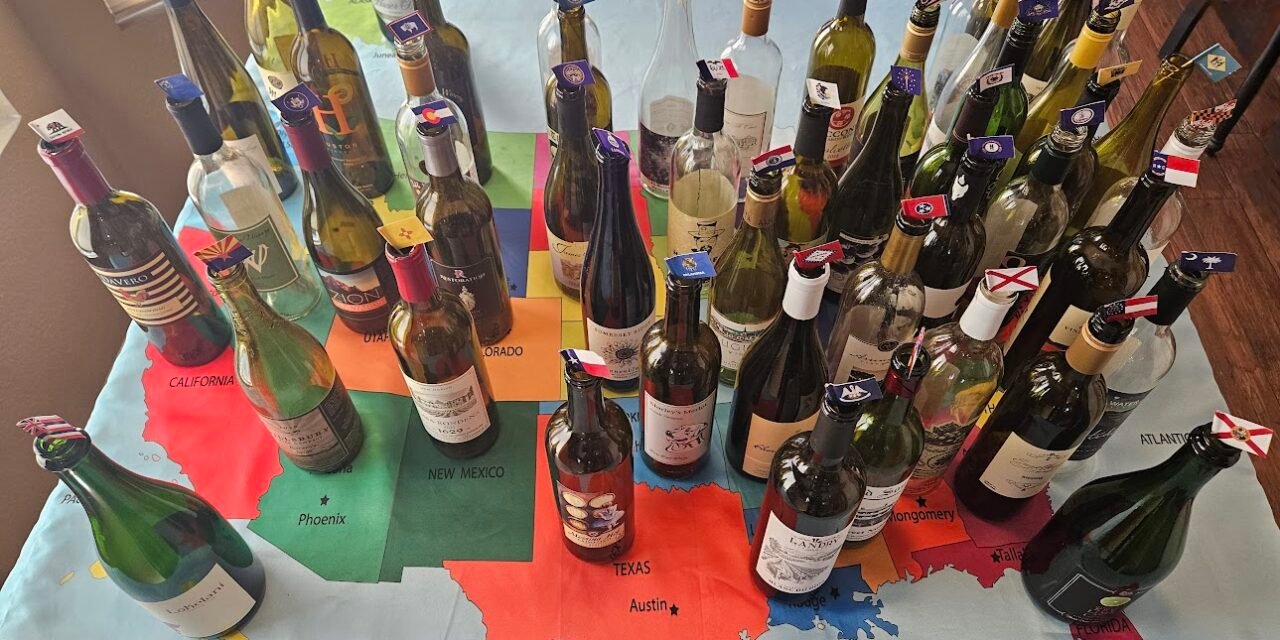
Before I share part 10 with you, I’d like to tell you how the pairing project came to fruition. The idea was born on a walk with my husband. I mentioned I wanted to write about something that, to my knowledge, hadn’t been done before. He asked me if all states made wine, and I said yes, to which he responded: well, all states have an iconic food or recipe; why don’t you collaborate with wineries across the country and pair their dishes with their wine? Brilliant, right!? I immediately reached out to wineries across the country, and before I knew it, bottles were showing up at my doorstep.
The rest is history. I hope you will enjoy my last batch and that you learned as much as I did about our nation’s gastronomy. And always remember, wherever you go, taste the local fare.

50 State’s Wine ©Darla Hoffmann
Hawaii
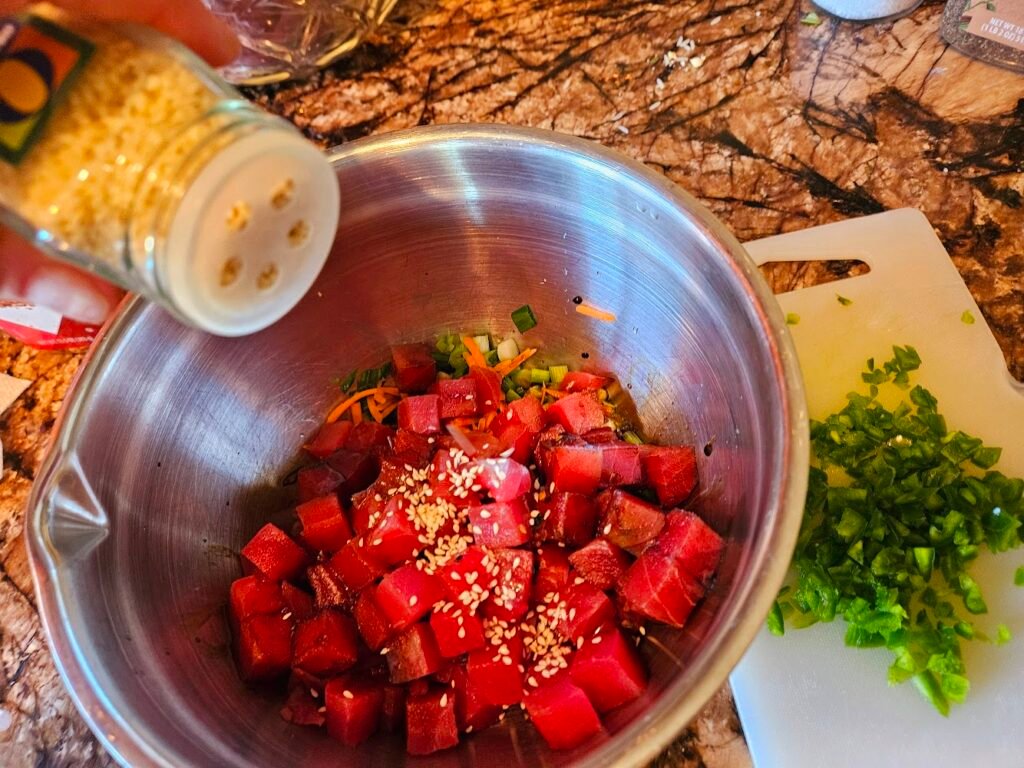
Ahi Prep! ©Darla Hoffmann
Fresh fish and local flavors embody the spirit of Hawaiian cuisine. Historically, poke has roots in ancient Hawaiian fishing practices, when people consumed fish raw immediately after being caught. “Ahi” refers to yellowfin tuna, a fish abundant in Hawaiian waters, and “poke” means “to cut” in Hawaiian, describing the way the fish is diced into bite-sized pieces. Over time, the dish evolved with various ingredients, such as soy sauce, sesame oil, and green onions, often influenced by Asian culinary traditions.
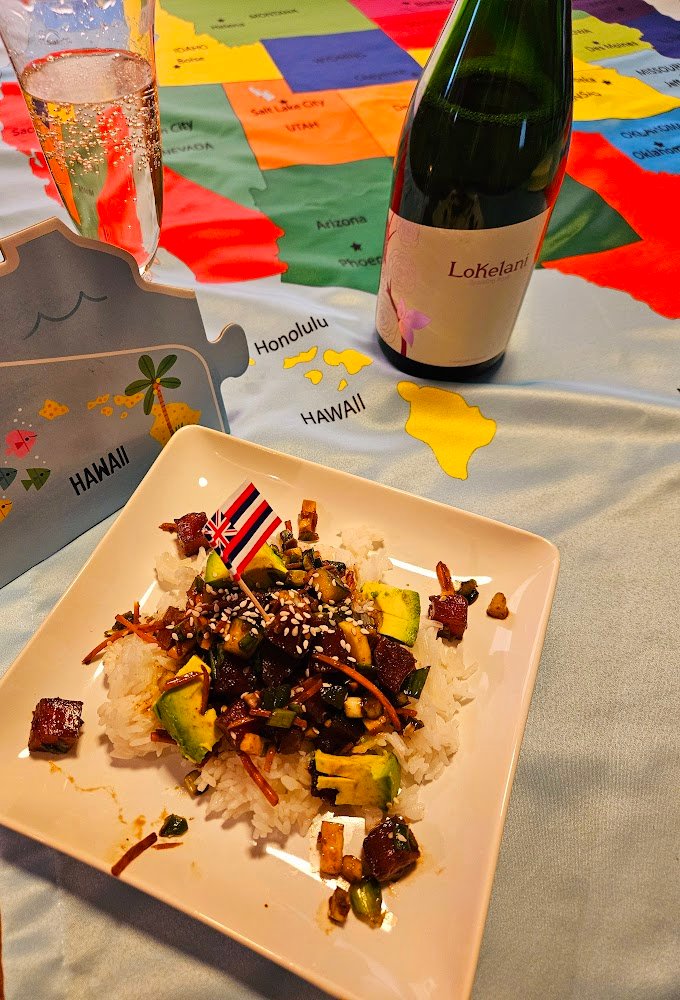
Ahi Poke paired with MauiWine’s Lokelani Sparkling ©Darla Hoffmann
Ahi Poke is easy and delicious. I purchased sushi-grade Ahi Tuna and cubed the fish into bite-size pieces. I combined the chunks with soy sauce, rice vinegar, shredded carrots, avocado, cucumber, jalapeno, green onions, sesame oil, and sesame seeds before serving it all over white rice.
MauiWine sent me their Lokelani, a Sparkling Pinot Noir and Chardonnay, for the pairing. The delicate sparkling rose made using the traditional method was as fresh as the Hawaiian Sea. The wine’s gentle spritz and vivid acid swam in sync with the salinity of the fish and its rich Umami mouthfeel. This pairing heightened the senses, equivalent to how the sound of crashing waves in Hawaii does for the soul.

Tasting Room at MauiWine ©MauiWine
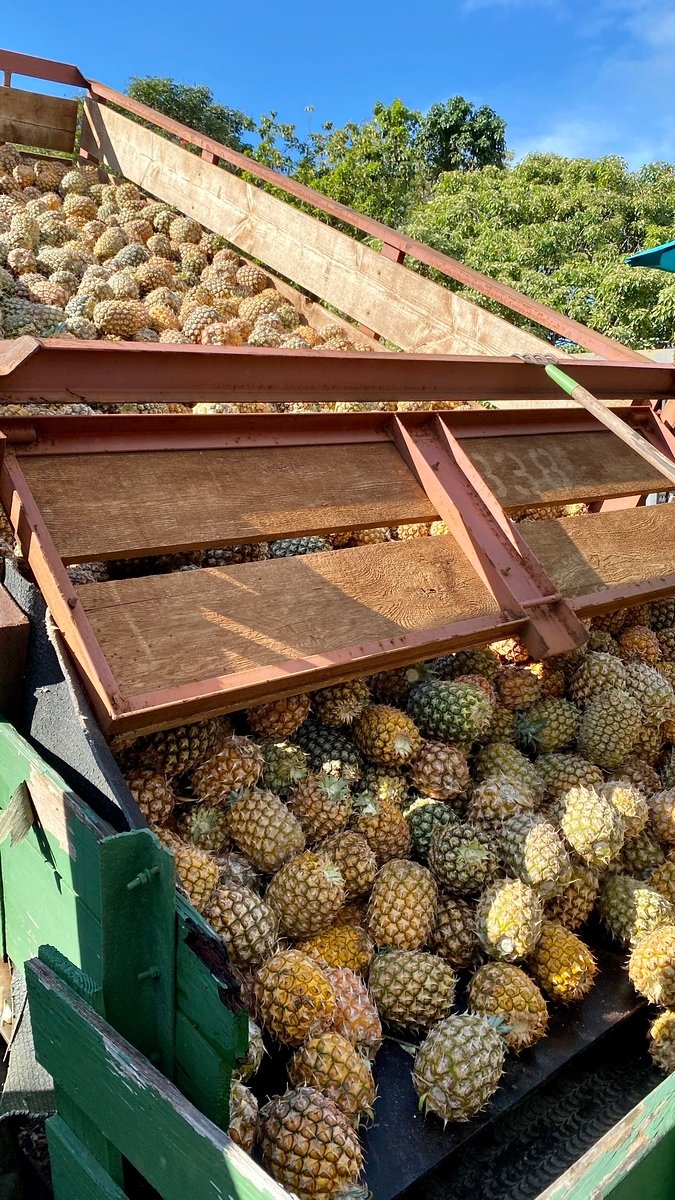
Pineapple Harvest ©MauiWine
MauiWine is enveloped by views of Maui’s southern coast and a stunning mountain backdrop. Owner C. Pardee Erdman created the winery on volcanic soils and distinct climate conditions to nurture grapes for wine. His passion for agriculture became MauiWine’s destiny; they welcome you with a gracious aloha in that slow-paced Hawaiian way to visit the King’s Cottage tasting room and gardens. MauiWine produces wine from estate-grown grapes, pineapples, and raspberries.
New Jersey

Prepping NJ Pork Roll ©Darla Hoffmann
John Taylor, a New Jersey native, invented what he called “Taylor’s Prepared Ham” in Trenton, NJ. Taylor developed the product to preserve pork and make it easier to store and ship. It is a processed meat that can be sliced and cooked, much like modern-day breakfast meat like bacon or sausage. It is now commonly referred to as “Taylor’s Pork Roll”.
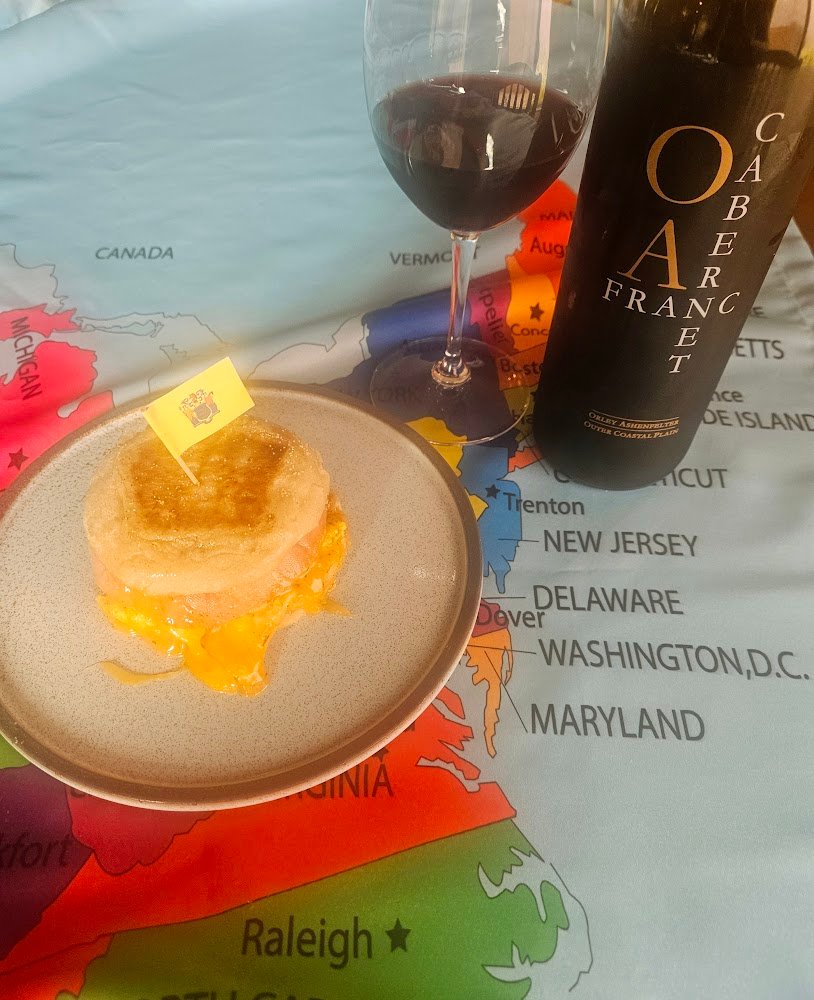
Pork Roll paired with Hawk Haven Vineyard & Winery’s Cabernet Franc
Much to my dismay, Taylors Pork Roll was readily available behind the counter at my local grocer. I cut a thick slice, fried it with an egg, added a slice of cheddar cheese, and served it on an English muffin.
Hawk Haven Vineyard & Winery proudly sent their Cabernet Franc for the pairing. The wine had a touch of green pepper, herbaceous notes, and red berry flavors, making it a great match for the pork’s spicy, smoky profile. The wine’s structure also stood up to the meat’s richness, and its acidity helped balance the pork’s fattiness.

Hawk Haven Vineyard & Winery ©Hawk Haven Vineyard & Winery

Hawk Haven bottles ©Hawk Haven Vineyard & Winery
The owners of Hawk Haven, Todd and Kenya Wuerker, opened their tasting room in 2008. However, the farmland, now planted to vine, has been in the family since the 1940s. The Wuerkers are huge advocates of promoting the wine industry in the Garden State and are constantly working on exciting new projects in the winery. I was thoroughly impressed with the Cabernet Franc; it was certainly an indication of quality grape growing and winemaking in New Jersey.
Rhode Island
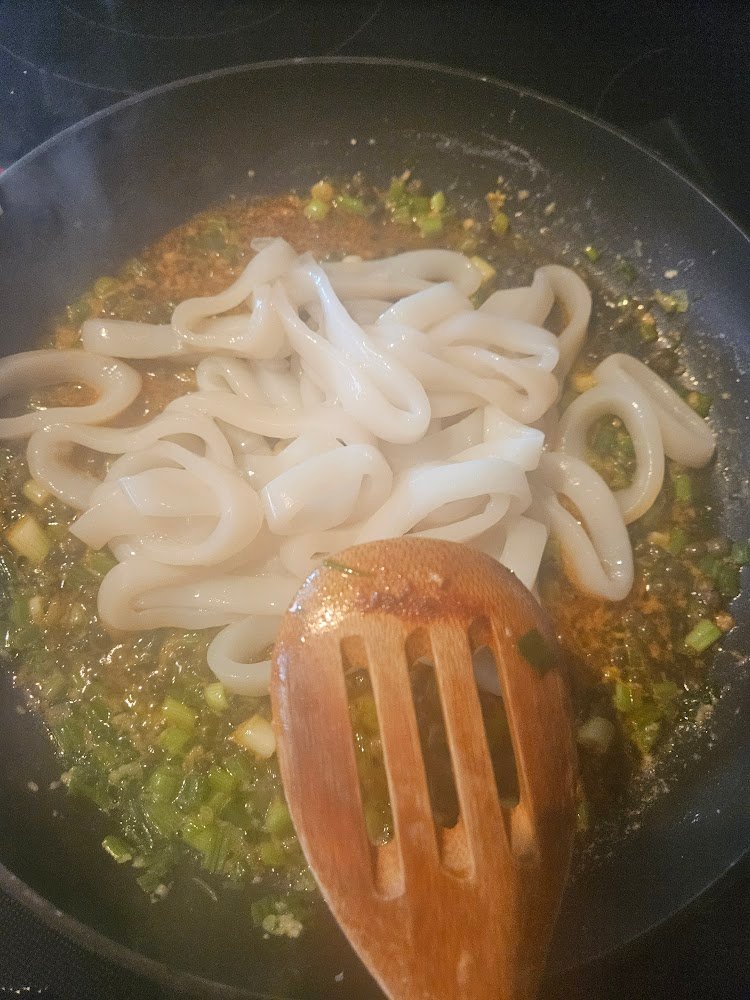
Sauteed Calamari ©Darla Hoffmann
Squid fishery is economically important to Rhode Island. The state has commercial fishermen who target squid, and it serves both the local market and contributes to the broader seafood industry. The fast-swimming sea creatures are abundant in the waters near the state. As of 2014, Calamari was officially named the state appetizer of Rhode Island.
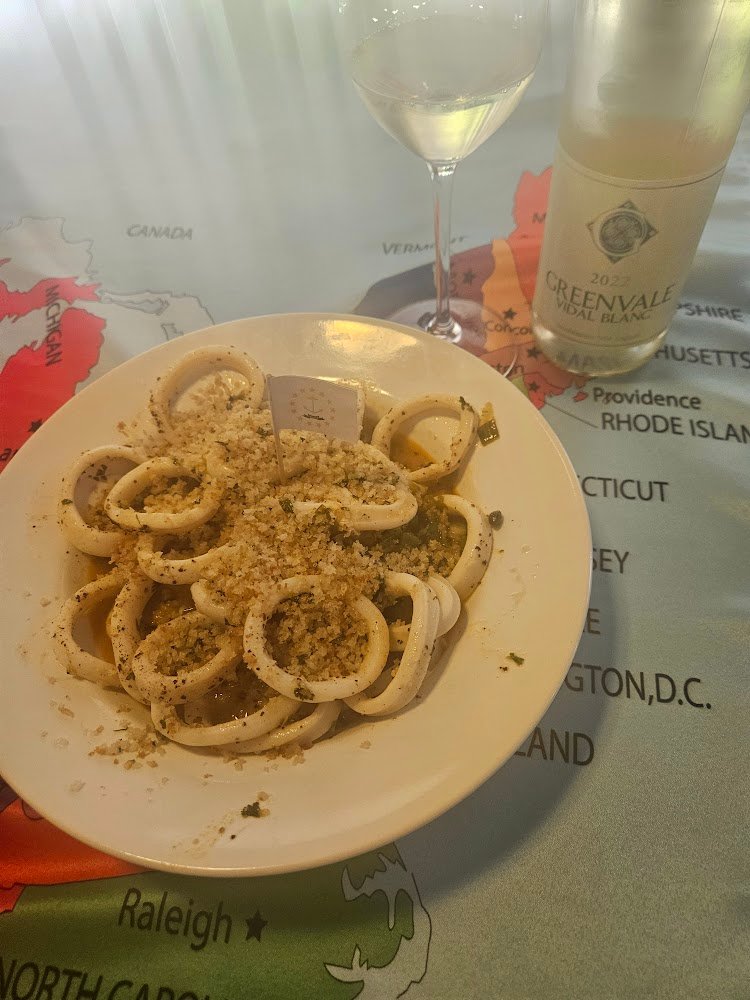
Calamari paired with Greenvale Vineyards Vidal Blanc
I sauteed garlic, jalapeno, green onions, and parsley in butter and olive oil for a few minutes. Then, I added capers and paprika, followed by the squid rings, until they turned opaque. Finally, I sprinkled a concoction of panko, butter, and parsley on top to serve as a light breading. The Calamari made an exquisite appetizer that I recommend serving with fresh crusty bread.
My friends at Greenvale Vineyards sent their bottle of Vidal Blanc to complement the dish. The wine’s acidity refreshed the palate between bites and balanced the oiliness of the pan-fried squid. Additionally, the wine’s notes of citrus and green apple enhanced the flavors of the Calamari, providing a bright contrast to the savory, briny taste of the sharp and tangy capers.

Greenvale Vineyards grounds ©Greenvale Vineyards
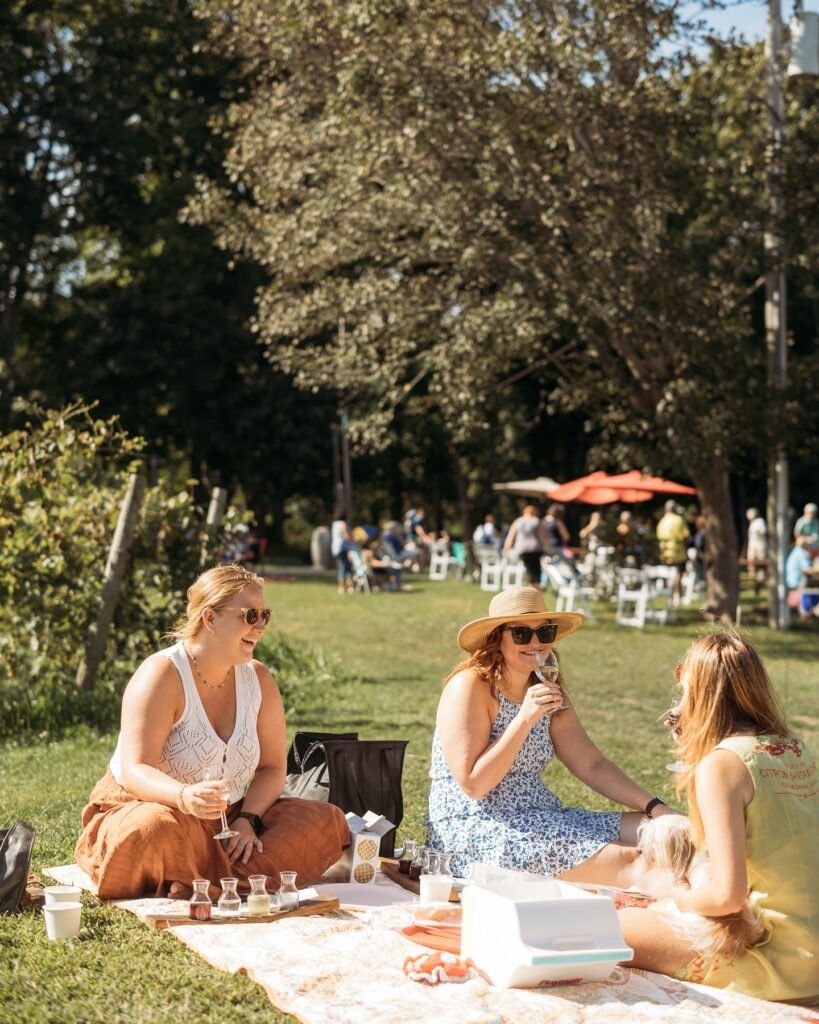
Sipping on the grounds at Greenvale ©Greenvale Vineyards
Greenvale Vineyard has become one of the most notable in the state due to its scenic location near the Sakonnet River, commitment to sustainable farming, and production of high-quality wines. The family and eighth-generation owners transformed their farm, established in 1863, into a vineyard in the 1980s. Their dedication to making wine from estate fruit and concept of country life have made them one of New England’s premier vineyards.
Connecticut
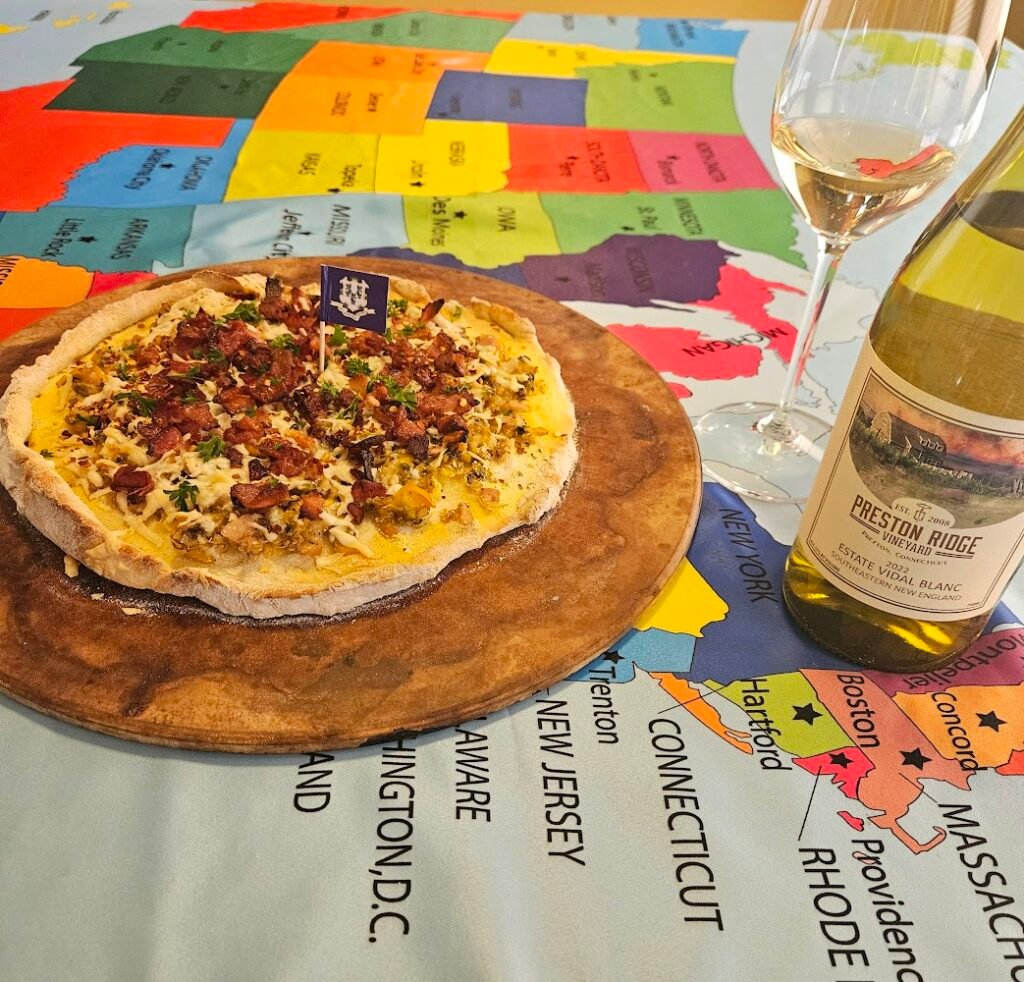
White Clam Pizza paired with Preston Ridge Vineyard’s Vidal Blanc ©Darla Hoffmann
White clam pizza is closely associated with Connecticut, specifically with the New Haven area, where it was popularized by Frank Pepe Pizzeria Napoletana somewhere around the 1960s. The combination of fresh clams, garlic, olive oil, and cheese on a pizza without tomato sauce is a unique twist that distinguishes it from traditional pizzas. Adding clams to pizza was an innovative way of combining the local seafood with Italian culinary traditions, and it quickly became a local favorite.
My first time making white clam pizza was surprisingly successful. The dough was a simple mixture of flour, rapid-rise yeast, sugar, salt, and warm water that only had to sit for 10 minutes before rolling. Next, I spread cornmeal and added toppings of grated Pecorino Romano, whole baby and chopped clams, garlic, oregano, cooked bacon, fresh parsley, and a drizzle of olive oil. After baking for 14 minutes, the clam pie was complete.
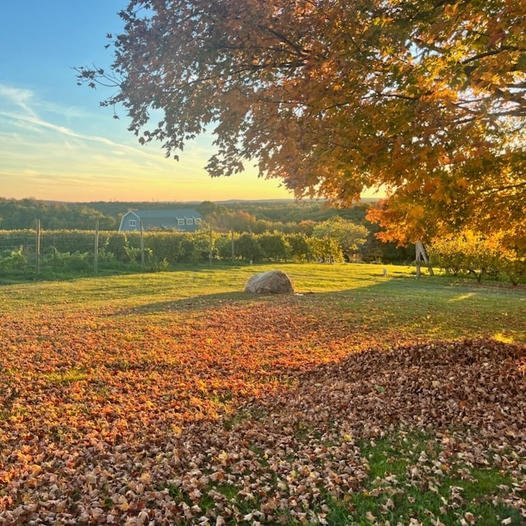
Preston Ridge Vineyard ©Preston Ridge Vineyard
Preston Ridge Vineyard selected their delicate yet zippy Vidal Blanc for the match. The wine’s subtle minerality complemented the clams’ oceanic flavors, enhancing the pizza’s seafood aspect. The wine’s citrusy orange profile lifted the herbs and garlic in the dish, keeping a harmonious interaction while creating a refreshing contrast to the creamy, savory richness of white clam pizza.

Preston Ridge Views ©Preston Ridge Vineyard
Preston Ridge Vineyard was founded in 2008 by the Sawyer and Helms families, who produced their first vintage in 2011. The six acres planted to vine on the 60-acre property are within the Southeastern New England AVA, allowing the cold-climate grapes to enjoy the influence of the coastal breezes. The families welcome you to visit their tasting room or host your next event or wedding on their beautiful grounds.
Alaska
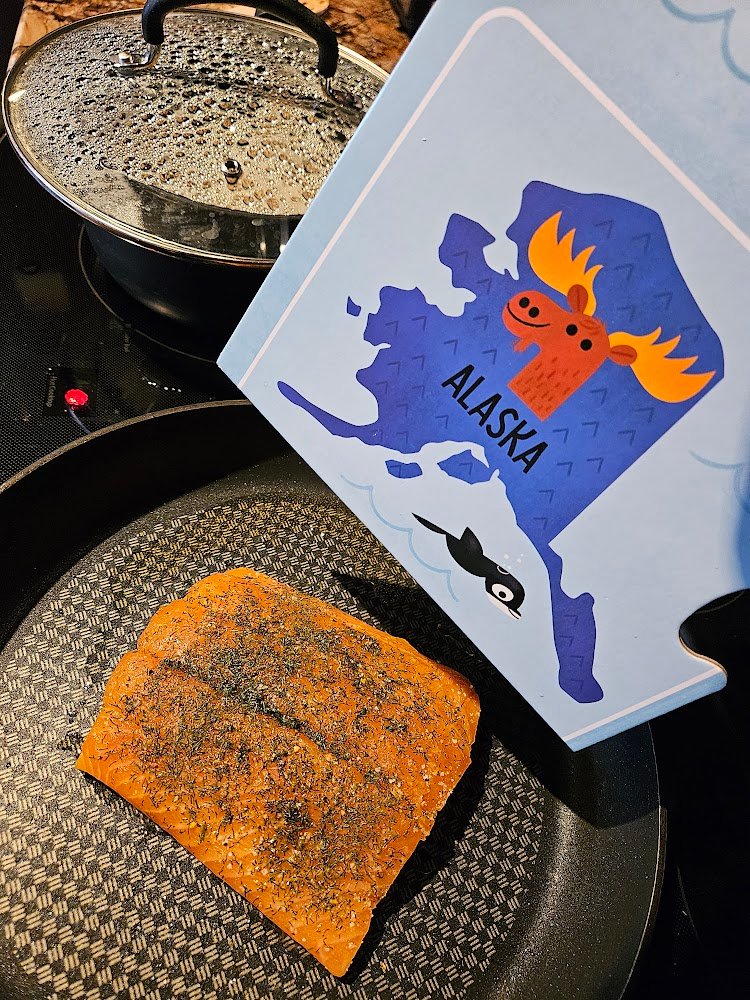
Cooking Salmon for Alaska ©Darla Hoffmann
The lifecycle of Salmon is iconic to Alaska. Their journey from freshwater rivers to the ocean and back supports a rich food web that includes bears, eagles, otters, and even trees and plants. For Alaska’s Native communities, Salmon has been a staple food for thousands of years.

Salmon paired with Bear Creek Winery’s Glacier Bear’s Apple Sparkling Wine ©Darla Hoffmann
Alaska’s salmon industry also has a significant economic footprint, supporting local economies. Worldwide exportation of the fish is an essential component of the global seafood market. Salmon symbolizes life in Alaska for all its ecological, cultural, economic, and nutritional benefits.
We make Salmon for dinner a few times a week in my household, so I know several different methods for this dish. I decided to prepare the Salmon with olive oil, dill, lemon pepper, and garlic salt, sauté it for about four minutes a side, and serve it over wild rice.
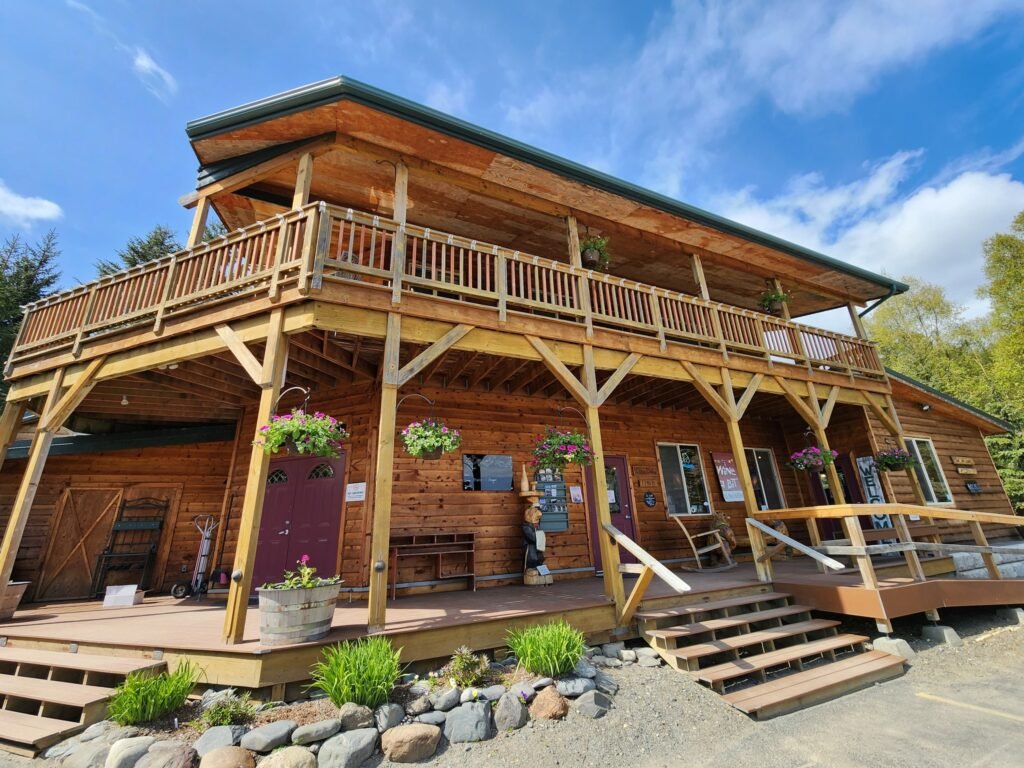
Bear Creek Winery ©Bear Creek Winery
Alaska’s Bear Creek Winery sent an apple sparkling wine from their sister brand, Glacier Bear, to pair with the state’s beloved fish. Made from fresh-pressed, locally sourced apples, the wine’s delicate effervescence and vibrant acid balanced the oily texture of the Salmon while elevating the lemon pepper spice and subtle saltiness of the fish.

Louis Maurer, owner of Bear Creek Winery ©Bear Creek Winery
Bear Creek Winery is alive today because Bill Fry, a wine enthusiast, became an experimentalist in the trade by making wine from berries, kiwi, and other kinds of fruit. It wasn’t long before Bill and his wife Dorothy opened their winery in 2003, and they have had the support of the community on their side ever since. The next generation, son-in-law Louis Maurer and daughter Jasmine are now at the helm and have expanded their facility and wine production, taking hospitality to a whole new level. The folks at Bear Creek continue to make wine from various fruits that thrive in their climate (including apples, berries, peaches, pomegranates, and grapes!) and environment to ensure quality in every sip. They warmly accept visitors and encourage you to make lodging reservations at one of their suites on their property to enjoy a relaxing weekend with sensational views and luxury amenities.
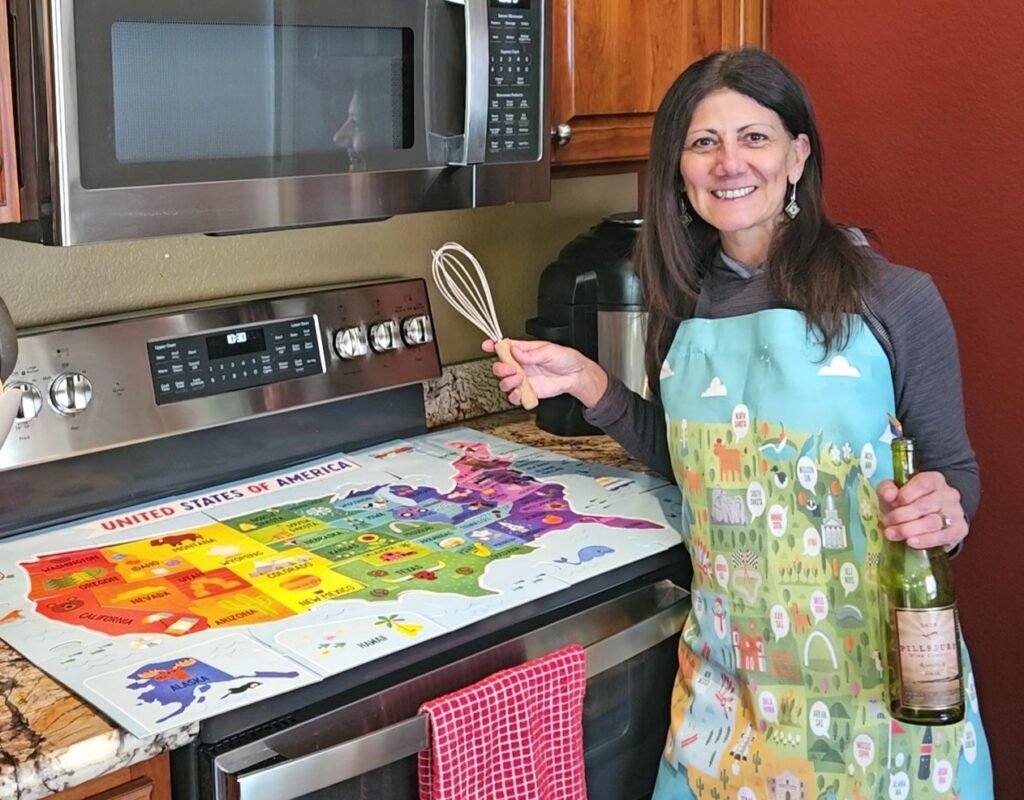
Cooking State Dishes ©Darla Hoffmann
My final pairings are complete, and as I officially close out the 2024 state food and wine pairing project, I raise a glass to every wine region across the United States. To the East, West, North, and South, from scorching hot temperatures to freezing conditions, hilltops to flatlands, gentle breezes to harsh winds, you are all honoring your craft and doing what it takes to make quality wine.
I am grateful to each winery that sent me a bottle; without you, my project would not have been possible. I did my best to follow your state recipes, and after tasting wine from all 50 states, I wholeheartedly affirm that you did right by your pairings. Thank you again, and cheers to continued success with the grape!
Thank you to Sherrie Wilkolaski, Editor-in-Chief and Co-Founder of Luxe Beat Magazine, for believing in the project and encouraging me to take it to the next level. Finally, I dedicate this project to my husband, for the idea that took me on a yearlong adventure with food and wine and for sharing my passion for each pairing. That’s a wrap!

